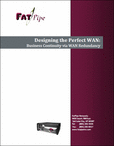Time Warner Cable Down – Internet Service Disrupted

I woke up to the news that Time Warner Cable backbone had gone down this morning. The report said TWC was handling a large volume of calls from customers. I am not surprised. Connectivity has long moved from the ‘nice to have” column to the “imperative” column. Customers need connectivity for a variety of reasons. I have no doubt business reasons predominate.
Fortunately for my team and myself, FatPipe customers are able to carry on due to the WAN redundancy FatPipe technology provides. While the customers have an interest to get the TWC connection up as quickly as possible – having a redundant connection affords them the luxury of time.
FatPipe’s router clustering technology would have been the perfect foil for this unforeseen event. While admittedly the available bandwidth would be smaller without the TWC connection, the secondary connection allows for uninterrupted connectivity. If you do not have WAN redundancy and were unfortunate enough to use TWC, we at FatPipe are here to assist you with reliability and redundancy solutions.
Please Like and Share


